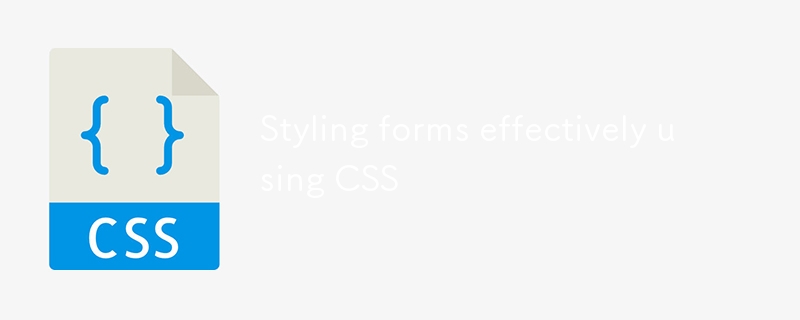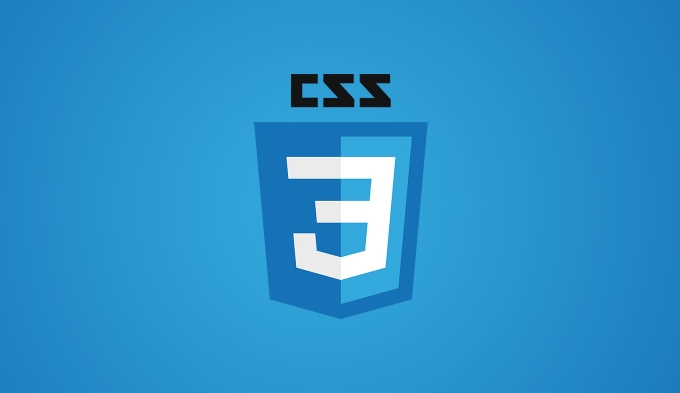Style the form through CSS to improve user experience and unify the page style. The specific methods are as follows: 1. Use universal reset styles to unify the appearance of form elements, and use flex or grid layout to optimize the structure to make the form items clearly arranged; 2. Use pseudo-classes such as: focus, :hover, :invalid and :valid to enhance state feedback and improve interactive intuitiveness; 3. Use native controls to hide native controls and simulate custom controls (such as check boxes) to improve visual consistency and better match the overall design style.

Forms are an important part of web interaction, but the default browser styles tend to appear monotonous and unattractive. Style the form through CSS, which not only improves the user experience, but also makes the overall style of the page more unified. The key is to master structure, state and detail control.

1. Basic style reset and layout optimization
The styles of form elements that come with the browser are quite different. It is recommended to use a general reset style to unify the appearance:

input, select, textarea {
border: 1px solid #ccc;
border-radius: 4px;
padding: 8px;
font-size: 16px;
outline: none;
}At the same time, a reasonable layout can improve readability and usability. You can use flex or grid to align labels and input boxes, such as:
.form-group {
display: flex;
flex-direction: column;
margin-bottom: 16px;
}
.form-group label {
margin-bottom: 8px;
}This allows each form item to be arranged clearly, making it easier for users to read and operate.

2. Status feedback enhances interactive experience
A good form should clearly reflect the user's operation status. You can set styles in different states through pseudo-class selector:
-
:focus: Highlight the field currently being entered -
:hover: Provide hover feedback -
:invalidand:valid: Show verification status
For example:
input:focus {
border-color: #007BFF;
box-shadow: 0 0 0 2px rgba(0,123,255,0.25);
}
input:invalid {
border-color: red;
}These small details make it easier for users to understand the current operation stage and also improve the intuitiveness of error prompts.
3. Custom controls improve visual consistency
Some native controls (such as <select> and <input type="checkbox"> ) perform inconsistently under different systems, and directly customizing them can improve visual unity. A common method is to hide native controls and emulate their functions with HTML CSS.
Take the check box as an example:
<label class="custom-checkbox"> <input type="checkbox" /> <span class="checkmark"></span> Agree to terms</label>
Cooperate with CSS:
.custom-checkbox input {
display: none;
}
.checkmark {
width: 16px;
height: 16px;
border: 1px solid #999;
border-radius: 3px;
display: inline-block;
position: relative;
}
input:checked ~ .checkmark {
background-color: #007BFF;
border-color: #007BFF;
}This method gives you complete control over the appearance of the controls and better match the overall design style of the website.
Basically that's it. The form style design seems simple, but to take into account compatibility, usability and aesthetics, you still need to spend more time on details.
The above is the detailed content of Styling forms effectively using CSS. For more information, please follow other related articles on the PHP Chinese website!

Hot AI Tools

Undress AI Tool
Undress images for free

Undresser.AI Undress
AI-powered app for creating realistic nude photos

AI Clothes Remover
Online AI tool for removing clothes from photos.

Clothoff.io
AI clothes remover

Video Face Swap
Swap faces in any video effortlessly with our completely free AI face swap tool!

Hot Article

Hot Tools

Notepad++7.3.1
Easy-to-use and free code editor

SublimeText3 Chinese version
Chinese version, very easy to use

Zend Studio 13.0.1
Powerful PHP integrated development environment

Dreamweaver CS6
Visual web development tools

SublimeText3 Mac version
God-level code editing software (SublimeText3)
 CSS tutorial for creating loading spinners and animations
Jul 07, 2025 am 12:07 AM
CSS tutorial for creating loading spinners and animations
Jul 07, 2025 am 12:07 AM
There are three ways to create a CSS loading rotator: 1. Use the basic rotator of borders to achieve simple animation through HTML and CSS; 2. Use a custom rotator of multiple points to achieve the jump effect through different delay times; 3. Add a rotator in the button and switch classes through JavaScript to display the loading status. Each approach emphasizes the importance of design details such as color, size, accessibility and performance optimization to enhance the user experience.
 Addressing CSS Browser Compatibility issues and prefixes
Jul 07, 2025 am 01:44 AM
Addressing CSS Browser Compatibility issues and prefixes
Jul 07, 2025 am 01:44 AM
To deal with CSS browser compatibility and prefix issues, you need to understand the differences in browser support and use vendor prefixes reasonably. 1. Understand common problems such as Flexbox and Grid support, position:sticky invalid, and animation performance is different; 2. Check CanIuse confirmation feature support status; 3. Correctly use -webkit-, -moz-, -ms-, -o- and other manufacturer prefixes; 4. It is recommended to use Autoprefixer to automatically add prefixes; 5. Install PostCSS and configure browserslist to specify the target browser; 6. Automatically handle compatibility during construction; 7. Modernizr detection features can be used for old projects; 8. No need to pursue consistency of all browsers,
 What is the difference between display: inline, display: block, and display: inline-block?
Jul 11, 2025 am 03:25 AM
What is the difference between display: inline, display: block, and display: inline-block?
Jul 11, 2025 am 03:25 AM
Themaindifferencesbetweendisplay:inline,block,andinline-blockinHTML/CSSarelayoutbehavior,spaceusage,andstylingcontrol.1.Inlineelementsflowwithtext,don’tstartonnewlines,ignorewidth/height,andonlyapplyhorizontalpadding/margins—idealforinlinetextstyling
 Creating custom shapes with css clip-path
Jul 09, 2025 am 01:29 AM
Creating custom shapes with css clip-path
Jul 09, 2025 am 01:29 AM
Use the clip-path attribute of CSS to crop elements into custom shapes, such as triangles, circular notches, polygons, etc., without relying on pictures or SVGs. Its advantages include: 1. Supports a variety of basic shapes such as circle, ellipse, polygon, etc.; 2. Responsive adjustment and adaptable to mobile terminals; 3. Easy to animation, and can be combined with hover or JavaScript to achieve dynamic effects; 4. It does not affect the layout flow, and only crops the display area. Common usages are such as circular clip-path:circle (50pxatcenter) and triangle clip-path:polygon (50%0%, 100 0%, 0 0%). Notice
 Styling visited links differently with CSS
Jul 11, 2025 am 03:26 AM
Styling visited links differently with CSS
Jul 11, 2025 am 03:26 AM
Setting the style of links you have visited can improve the user experience, especially in content-intensive websites to help users navigate better. 1. Use CSS's: visited pseudo-class to define the style of the visited link, such as color changes; 2. Note that the browser only allows modification of some attributes due to privacy restrictions; 3. The color selection should be coordinated with the overall style to avoid abruptness; 4. The mobile terminal may not display this effect, and it is recommended to combine it with other visual prompts such as icon auxiliary logos.
 What is the CSS Painting API?
Jul 04, 2025 am 02:16 AM
What is the CSS Painting API?
Jul 04, 2025 am 02:16 AM
TheCSSPaintingAPIenablesdynamicimagegenerationinCSSusingJavaScript.1.DeveloperscreateaPaintWorkletclasswithapaint()method.2.TheyregisteritviaregisterPaint().3.ThecustompaintfunctionisthenusedinCSSpropertieslikebackground-image.Thisallowsfordynamicvis
 How to create responsive images using CSS?
Jul 15, 2025 am 01:10 AM
How to create responsive images using CSS?
Jul 15, 2025 am 01:10 AM
To create responsive images using CSS, it can be mainly achieved through the following methods: 1. Use max-width:100% and height:auto to allow the image to adapt to the container width while maintaining the proportion; 2. Use HTML's srcset and sizes attributes to intelligently load the image sources adapted to different screens; 3. Use object-fit and object-position to control image cropping and focus display. Together, these methods ensure that the images are presented clearly and beautifully on different devices.
 What are common CSS browser inconsistencies?
Jul 26, 2025 am 07:04 AM
What are common CSS browser inconsistencies?
Jul 26, 2025 am 07:04 AM
Different browsers have differences in CSS parsing, resulting in inconsistent display effects, mainly including the default style difference, box model calculation method, Flexbox and Grid layout support level, and inconsistent behavior of certain CSS attributes. 1. The default style processing is inconsistent. The solution is to use CSSReset or Normalize.css to unify the initial style; 2. The box model calculation method of the old version of IE is different. It is recommended to use box-sizing:border-box in a unified manner; 3. Flexbox and Grid perform differently in edge cases or in old versions. More tests and use Autoprefixer; 4. Some CSS attribute behaviors are inconsistent. CanIuse must be consulted and downgraded.






